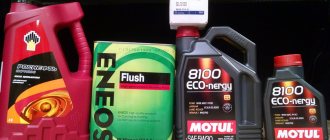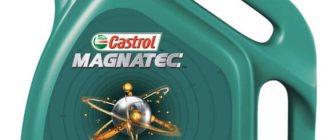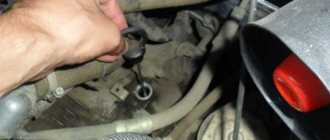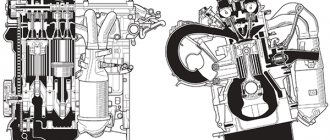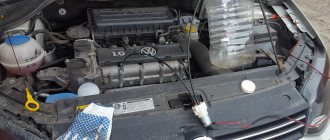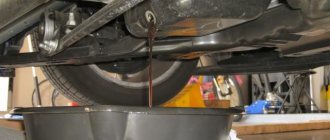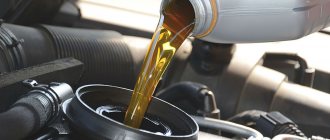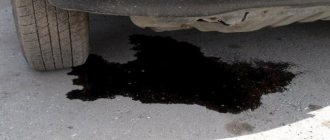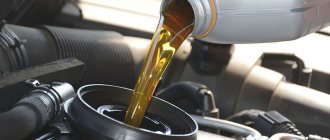Long years of use, the use of low-quality motor oil and an aggressive driving style can, over time, worsen the condition of the vehicle's propulsion system. And this will be evidenced by such symptoms as loss of power, “rattling” of parts, the appearance of black exhaust smoke, and rapid consumption of fuel and lubricants. This situation in the engine is created by particles of dirt and metal shavings, which clog the gaps of the structure and immobilize it. Flushing motor oil helps combat this disease. Today we’ll talk about all the nuances of its use and figure out how to choose flushing oil for the engine.
Top 5 flushing oils
Flushing oils have been on the world market for several years, so they have already earned a certain reputation for themselves. Let's look at the TOP 5 most popular “oil” brands:
- ENEOS . Flushing oils of this brand are in wide demand on the world market due to their unsurpassed cleaning parameters: they cope with long-term deposits and do not have an aggressive effect on the elements of the power plant. ENEOS oils not only carefully clean the internal surfaces of the installation, but also prevent dirt from re-depositing on clean elements. By the way, you only need to use this flushing oil for 10 minutes - during this time it will carry out all the necessary operations.
Flushing oil ZIC
- Zic . This car engine flushing oil was included in our rating due to its high cleaning abilities. It effectively removes deposits by thoroughly softening them. It is worth noting that the liquid does not have the habit of corroding the sealing elements of the structure, which increases its attractiveness among competitive products. The oil contains carbons, organic solvents and anti-wear additives. This product helps clean the engine in the most inaccessible places. However, flushing oil can only be used in new engines: it cleans the working area so effectively that it can cause the “needed parts” to be removed from the system. This will cause serious damage to the car in the shortest possible time.
- TNK . Domestic brands often “pop up” among the products selected by users. The main advantage of TNK oil is its ability to treat old power plants. It effectively removes deposits without affecting crystallized particles. This skill allows you to avoid engine failure due to the formation of countless cracks and defects after washing. When choosing TNK flushing oil, you can be sure that its effect on the power plant is safe.
- Shell . Shell products produce truly worthy technical fluids, which are actively used in professional auto repair shops. The manufacturer claims that the oil is able to cope with all deposits without causing complications in the operation of the system and effectively flushing out all dissolved substances. Numerous driver reviews confirm this. The only negative that some car enthusiasts encounter is the rapid wear of the oil seals after washing.
- Liqui Moly . German-quality fuels and lubricants are in high demand due to specialized flushing additives, which are popularly called “five-minute additives.” The principle of their operation is very simple - the required amount of liquid is poured into the engine, after which the car operates at minimum speed for 5 minutes. Due to the high concentration of strong chemical solvents, cleaning does not take much time. The main weakness of such additives is cars with high mileage. They can only be used to wash out deposits in modern engines, otherwise the piston group, seals and other structural elements will suffer.
Engine flush options
1. When can you get by? A new car, just purchased, obviously does not require any engine flushing at the first oil change, of course, if there were no force majeures on the road, and mineral oil did not have to be urgently added to the synthetics. Of course, this is nonsense, but anything can happen - you’re on the highway, you don’t have a liter in the trunk to top up your oil, and the village store doesn’t spoil you with a selection. Accordingly, having reached civilized land, the oil urgently needs to be replaced with a new one, having first cleaned the engine.
2. Five minutes. A car with vigorous operation after 5 replacements necessarily requires flushing the engine. For this option, five-minute remedies are quite suitable. There is a wide choice, but you need to take into account that each oil manufacturer also includes various flushing products in its line. Therefore, it is better to proceed from what kind of engine oil you constantly use in your car.
3. Flushing oil. For cars with mileage over 100,000 km, things are not so simple. Conventional quick flushes are no longer suitable and you need to choose a special flushing oil. Many manufacturers say that such oils should be added again during testing and driven for about 50 km, as practice shows, 20-30 km is quite enough.
4. The old-fashioned way. Oddly enough, the “old-fashioned” method of washing with diesel fuel is cheaper and safer than imported and domestic chemicals. Of course, it takes a lot of time, but it reliably and guaranteed cleans engine contaminants of any nature and nature. Again, diesel fuel is diluted with oil 3:1 for a reason. Three parts of oil are guaranteed to save the engine from all misfortunes during the entire 15-minute ritual with washing. The three stages of starting the engine at idle are not accidental, since the engine is “washed” in a gentle mode without load.
Is it worth washing?
No matter how much demand there is for engine flushing oils, the question of the need to use them should be raised first.
Flushing oil is poured:
- After purchasing a used car. This measure helps prevent consequences that are detrimental to the system, because Before selling, former owners do not strive to bring the car into perfect condition, but create an imitation of a well-maintained car. In fact, a technical inspection is still carried out before sale, but low-quality lubricant is used for lubrication.
- When switching from one engine oil to another. Moreover, it does not matter what changes - the chemical base, viscosity or manufacturer - it is necessary to fill the engine with flushing fluid in any of the listed cases.
- In case of aggressive driving. The more often the car “takes off” and stops “in its tracks,” the worse the power plant feels. And if at first it may encourage your desire to go ahead at traffic lights, then over time the resource and power characteristics will decrease. And quickly. In order to maintain a stable condition of the engine system, it is recommended to clean it every time the engine lubricant is changed.
Flushing oil is not used:
Filling with flushing fluid
- With smooth driving and careful care of the vehicle. No matter how many kilometers your vehicle travels and no matter what conditions it is used, if high-quality lubricant (which includes detergent additives) circulates under its hood, then you do not need to bother with flushing the engine.
- If the vehicle is more than ten years old. The use of flushing bases in this case is appropriate either under the supervision of experienced specialists, or is not appropriate at all: chemical solvents can destroy the entire engine installation.
- If two or more types of motor oils have never been mixed in the working area of the car.
This is the kind of information you need to use when deciding on the advisability of using flushing oils in a car.
Is it worth using
While some are thinking about which flushing oils would be best to use, others strongly doubt the need to use them. Therefore, this question also needs to be answered.
The main competitor of flushing oil (FU) is the so-called five-minute oil. But against its background, PM has a number of obvious advantages. The main one is a safer and gentler effect on the internal components of the internal combustion engine.
Most five-minutes use the most aggressive components in their composition. These solvents actually wash away old grease residues and other contaminants. But at the same time, oil seals and seals are destroyed, a negative effect on the metal is observed, and the likelihood of the development of oxidation processes and the formation of rust spots increases.
Another argument against five minutes is the fact that when drained, some of these aggressive liquids remain inside. When mixed with new oil intended for constant use and operation of the car, the composition of the lubricant changes. And not always for the better.
In practice, you can do without flushing oils. But then there is a possibility of encountering negative consequences for the power unit. The thing is that when filling in new lubricant, it mixes with the remnants of the old one, as well as with the contaminants, carbon deposits and suspensions accumulated in the crankcase. This instantly changes the characteristics and physical and chemical properties of the fresh fluid, reduces its service life, clogs the oil filter and shortens the service interval.
There are several conditions under which flushing oils may not be used:
- you bought a new car;
- Previously, the oil was changed strictly according to regulations and as needed;
- when replacing, compositions recommended by the manufacturer or of higher quality were used;
- over all the years of service, poor quality oil has never entered the engine crankcase;
- compounds of different brands or with different characteristics were never mixed in the engine.
When even one of the conditions is not met, preventive flushing is recommended.
Experts and experienced motorists advise that you definitely use high-quality flushing oil if:
- The car was purchased second hand and its service history is questionable.
- Clear signs of sediment accumulation have formed in the upper part of the internal combustion engine.
- You need to switch from one type of oil to another.
- The machine was subjected to heavy loads and operated in difficult conditions.
- The internal combustion engine was recently overhauled.
Even if you practice using inexpensive and not the highest quality oils, flushing as a preventative measure definitely won’t hurt.
Selecting the required fluid
There are three basic rules that help answer the question: “how to choose flushing oil for the engine.”
Rule 1. Use all possible resources (Internet, magazines, advice from qualified specialists) to select a flushing oil manufacturer. Yes, in advertising brochures and on official websites they praise the advantages of their own products, but in reality it may turn out that the stakes are too high, and technical fluids do not produce the desired effect. Read the results of testing working products, read reviews from car owners. Preference should be given to those products that have real test results to verify their quality.
Rule 2. Don’t skimp and choose lubricants from well-known brands. Flushing oils are not that expensive, so there is no point in looking for benefits from the purchase - cheaper options can trigger oxidative reactions inside the engine compartment.
Flushing oils
Rule 3. Before paying money for the selected liquid, conduct a visual inspection of the container in which it is sold. Leading brands will not save on packaging, so any doubts about the quality of the product may mean a fake in your hands. By the way, you should purchase chemicals only at specialized retail outlets.
Additives as first aid for the engine
An option for flushing oil are various five-minute additives, which are designed to restore the cleaning properties of used motor oil. For this purpose, additives are added to the burnout, and then the engine is started at idle for about 5 minutes. After draining the waste, the filter must be replaced and fresh motor power must be added. Such “five-minute” cleaners clean dirt from the walls of the engine very well, but they cannot remove sludge. Why? In order for the sludge particles to be washed out of the oil line and into the oil, a purified flushing fluid is needed. Used motor fluid is already oversaturated with dirt and is incapable of dissolving debris on the walls of the internal combustion engine. When working with additives, you must strictly follow the instructions, since they contain quite aggressive chemicals. If you make the engine run for more than the specified time, you will have to change not only the oil, but also the seals. Thus, the additives are intended for very dirty engines. How can a car enthusiast choose a high-quality and effective additive correctly? Such ICE cleaning products are produced by many companies, but additives from the Motul and Liqui Moly brands are especially famous.
Not all additives are equally effective
When the engine needs treatment
In what situations does it become necessary to flush a diesel or gasoline engine:
- Buying a used car with a high mileage. Typically, such vehicles have unclear previous operating conditions, and the engine contains debris in the form of particles of used motor fluid. To effectively and at the same time carefully wash the engine, a step transition is used. After filling the flushing oil, the internal combustion engine should run for no more than half an hour. Drain it and pour in good quality mineral water, chemically suitable for your engine according to API and SAE. After 1000–2000 km, the time will come to replace the engine fluid with a high-quality product several times. If the oil seals sweat or oil consumption increases, you will have to tinker with replacing the oil seals, repairing the engine, or going back a step.
- Do you want to switch from mineral water to semi-synthetic or synthetic water? In this case, flushing the engine is simply necessary to prevent the more purified oil from washing out mineral deposits and clogging the oil filter and channels.
- Using only one type of engine oil from one brand eliminates the need for flushing between changes. If you are switching your car to another brand of oil, your engine will need a flush. The use of semi-synthetics or synthetics from different manufacturers forces you to flush the engine every 3-4 shifts. After flushing the engine, you should change the oil filter the first time after 2000 km, the second time after 6000–8000 km. Now the period for changing the filter for your car is reduced by 2000–4000 km. If your engine runs only on mineral oil, flushing should be done every shift.
- In emergency situations, when there is suspicion of fake motor fluid of unknown origin or several types of oils have been mixed.
- When you want to transfer the internal combustion engine to work with a higher class of oil of any classification. This situation is observed at the end of autumn - many motorists switch their cars from mineral water to semi-synthetic.
Flush the engine correctly
Flushing oil has been selected, but how to flush the engine with flushing oil? The following instructions will help you with this:
- Buy two oil filters. Moreover, one of them may not be of very good quality; you will only use it for washing.
- Place the car on a level surface. If the engine is not warmed up, drive the car for 20-30 minutes.
- Drain the used fluid by unscrewing the drain plug and then the old oil filter.
- Reinstall the plug and attach a new filter element.
- Fill in flushing engine oil through the oil filler neck. Control its volume using the marks on the special probe. The liquid should not be higher or lower than the “MAX” indicator.
- Wash the engine for the time specified in the instructions for use of the product you have chosen. To do this, start the car and leave it idling.
- Drain the flushing oil.
- Replace the oil filter with a new one and pour fresh lubricant under the hood.
Why flush the engine?
When the engine operates and fuel burns, carbon deposits appear. Most of them leave through the exhaust system, but sediment still remains in the crankcase and oil. Lubricant is unable to dissolve all carbon deposits.
Because of this, a varnish coating appears inside the internal combustion engine. Gradually, under the influence of temperature and oxidation, more and more layers appear in the power unit. This leads to increased engine wear and further expensive repairs.
Is it necessary to wash the internal combustion engine? Each car owner must make his own decision. When using cheap mineral water together with low-quality fuel, a large amount of deposits is formed in the engine. Flushing must be carried out in order to eliminate them in time.
Another reason for flushing the internal combustion engine is its overheating. This happens quite rarely. When the lubricant heats up too much, its service life is greatly reduced, therefore, parts wear out faster.
Expired engine oil in the engine
It is advisable to carry out flushing when the car oil has not been replaced for a long period of time. Cleaning the internal combustion engine allows you to increase the duration of its operation, eliminate problems in the oil complex, coking of the pistons, and hydraulic compensation noise.
Of course, minor malfunctions in the functioning of the power unit can be ignored until a certain point.
However, increased fuel costs, decreased engine performance, and problems with starting the internal combustion engine will sooner or later turn into serious problems requiring expensive repairs.
Cautions
Deposits on the oil intake
Even if you choose the best flushing oil, according to global consumers, you may come to the conclusion that using it to increase engine life was not a good idea. If before the procedure the car did not give serious reasons for concern, then after liquid cleansing “surprises” may begin in the form of rapid aging of the lubricant, its excessive consumption, and even a complete stop of the crankshaft.
A similar situation arises in cases where flushing agents have to deal with many years of blockages in old cars whose owners did not follow basic maintenance rules. For example, flushing the engine of a vehicle, in which a low-grade lubricating fluid has been “splashing” for a long period of time, which is not suitable for its viscosity properties, and, moreover, has not been changed in a timely manner, with flushing oil is unacceptable. After all, after filling it, an instant process of peeling off a thick layer of “deposits” will begin, which, being washed out through the channels of the lubrication system, can simply clog them. This seemingly useful procedure can cause oil starvation even after adding fresh lubricant. There is no need to remind you what this entails. Therefore, before starting the procedure, think several times - is it really necessary to flush the engine or is it enough to just pour high-quality oil into it.
Types of washing liquids
“Five Minute” improves the cleaning and dispersing characteristics of additive substances that are contained in motor oil and better clean the engine from various formations. It reduces the viscosity of the lubricant.
This makes its circulation easier. Within thirty minutes of operation of the power unit, the flushing agent evaporates without damaging the engine.
All five-minute engine flushes can be divided into the following types:
- soft, used to prevent pollution;
- medium, having more active properties;
- professional, providing high-quality cleaning of the car's lubricating complex.
In Russia, the “five-minute” OIL System Spuling Light from . It is classified as a soft wash. This fluid is recommended for use when switching from one lubricant to another. It can be seen both in online stores and in regular retail outlets.
Incorrect use of five minutes
Typically, a 5-minute engine flush is poured into old motor oil (three hundred and fifty milliliters per four liters). Due to the fact that it has high alkalinity, the lubricating film can be washed off the spare parts along with the dirt.
To prevent this, you need to use a flushing agent only when the engine is idling, otherwise scuffing may appear on ungreased parts.
“Five-minute liquids” of Liqui Moly contain additives with phosphorus and zinc additives. They resist scuffing and greatly reduce the chance of damaging the engine during operation.
Alternative to flushing oil
The detergent additives included in the flushing oil do not completely remove contaminants from the engine compartment. They cope with only 50-70% of contaminants and cannot completely rid the engine of long-term accumulations. A truly effective alternative to such a fluid is mechanical cleaning of the power plant. Yes, it’s not easy to do - after all, you will need to disassemble the car into its component parts. But the result is worth it. Mechanical cleaning allows you to remove long-term coked deposits and at the same time assess the condition of working mechanisms. If they are severely damaged, cracked or chipped, then during engine disassembly you can replace the problematic parts.
Consequences of engine flushing
Due to low-quality oil, sticking of the oil scraper and compression rings, which are located on the pistons of the cylinder-piston group, can occur. The result of this process is the rings losing their mobility. The consequences are loss of compression, which will immediately affect engine power. In addition, lubricant waste will increase, because oil scraper rings will not be able to prevent it from entering the combustion chambers. You will need to use flushes that can remove carbon deposits, soot deposits, and other harmful sludge. As a rule, after this procedure, compression is restored, and engine oil burns much less.
In addition to the positive cleaning effect, the flushing composition can also cause harm - for example, cause oil leakage through the seals.
When cleaning the engine, flushing flushes out toxins from the seals. As a rule, they are deposited in the cracks of these sealing parts, clogging them. Thus, the lubricating fluid does not leak out. After flushing, the situation changes and engine fluid penetrates through the seals. This is another reason why you need to choose only high-quality flushing material.
After flushing the engine, a small amount of cleaning solution always remains in it. It contains components designed to attack deposits. Mixed with new oil, these substances continue their work. When exposed to engine parts, such as seals or gaskets, for a long time, they will begin to destroy them. That is why the engine should be flushed only in cases where it is no longer possible to do without this procedure.
Choosing the best oil
The best flushing agents are essentially mineral or semi-synthetic oils. Moreover, even service specialists cannot always identify the best of them.
Choosing an engine flush is not difficult if you remember what kind of regular oil is poured into the engine. If it is synthetic, then the flushing should be based on this. For mineral oil, the same flushing agent should be used. By and large, information on recommended oils can be found in the car manuals. You should rely on it when choosing. At the same time, we should not forget about the brand under which the wash is produced.
Domestic car enthusiasts prefer products from the following brands:
- ZIC . South Korean oils and washes are produced under this brand. They have good characteristics. In addition, such products prevent corrosion and prevent lubricants from foaming when overheated. ZIC brand products do not harm various gaskets and seals. With regular use, you can be sure of the cleanliness of the engine.
- Rosneft . A domestic manufacturer produces good mineral washes, which mainly use foreign additives. The products of this company can be used for flushing both gasoline and diesel engines. Recommended for those car owners who switch from one oil to another after a long mileage.
- Spectrol . This is another domestic brand. Its products allow you to get rid of sediment that remains in the engine after skipping routine maintenance. Despite their excellent cleaning properties, Spectrol washes are non-abrasive.
- Luxe Motor Flush . This flush is based on mineral oil. It contains additives that increase the efficiency of removing toxins from the internal elements of the power unit. It is able to dissolve low-temperature deposits and clean the oil receiver.
- Liqui Moly . German washes are considered safe and effective. They gently and carefully remove dirt from all elements of the power unit and do not harm the seals. After use, a protective layer remains on the internal surfaces of the engine.
- TNK . This company produces 2 types of washing agents: standard and express. They can be used for any type of propulsion systems. They contain all the necessary additives for effective cleaning. After use they fade completely. Works well with other oils.
This is interesting: How to change the battery in a Volkswagen car key in 1 minute?
This is not a complete list of popular washes. When purchasing them, there is less chance of running into a fake than when purchasing cleaning products from other brands. The manufacturer protects its product as much as possible.
